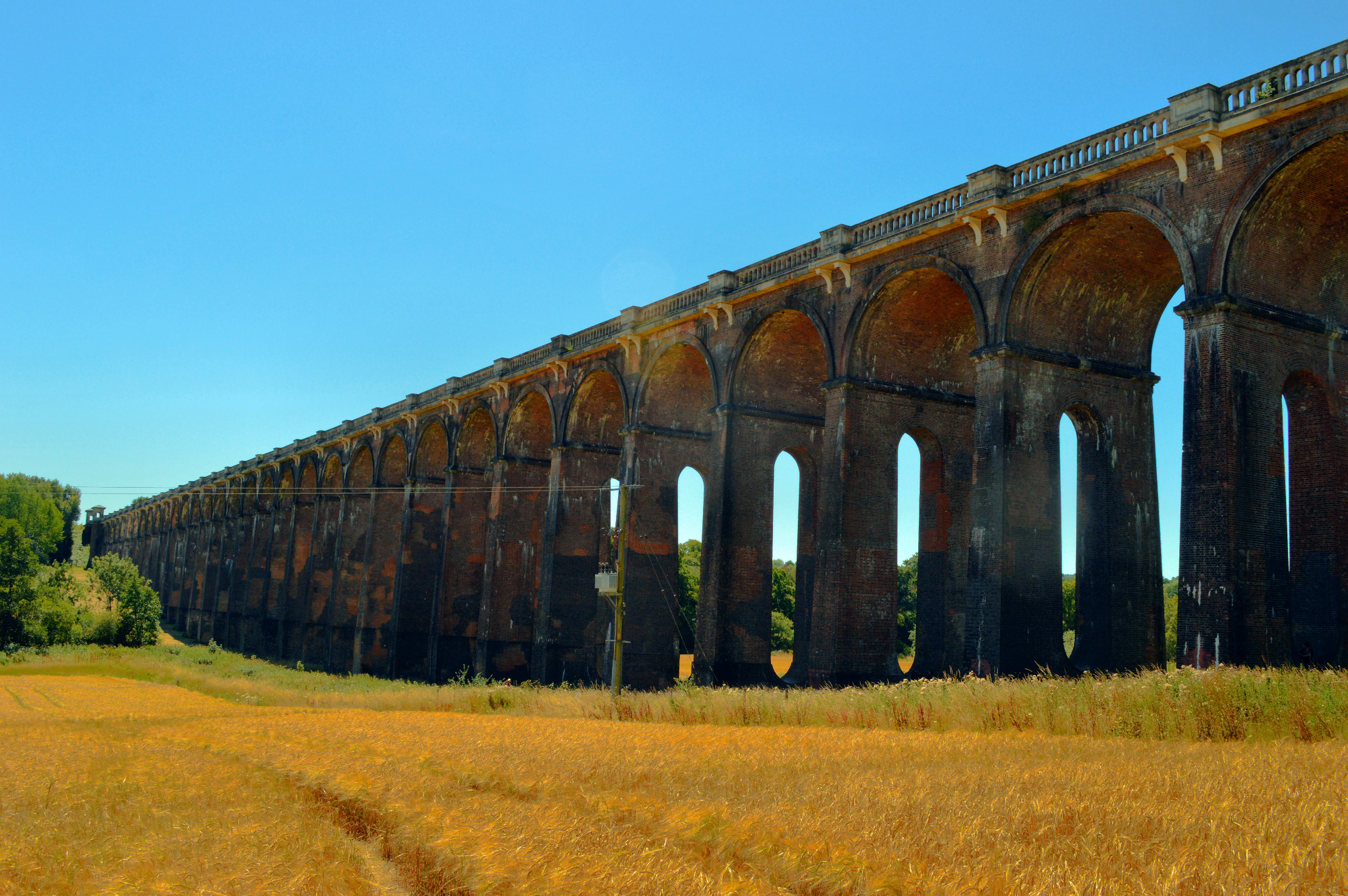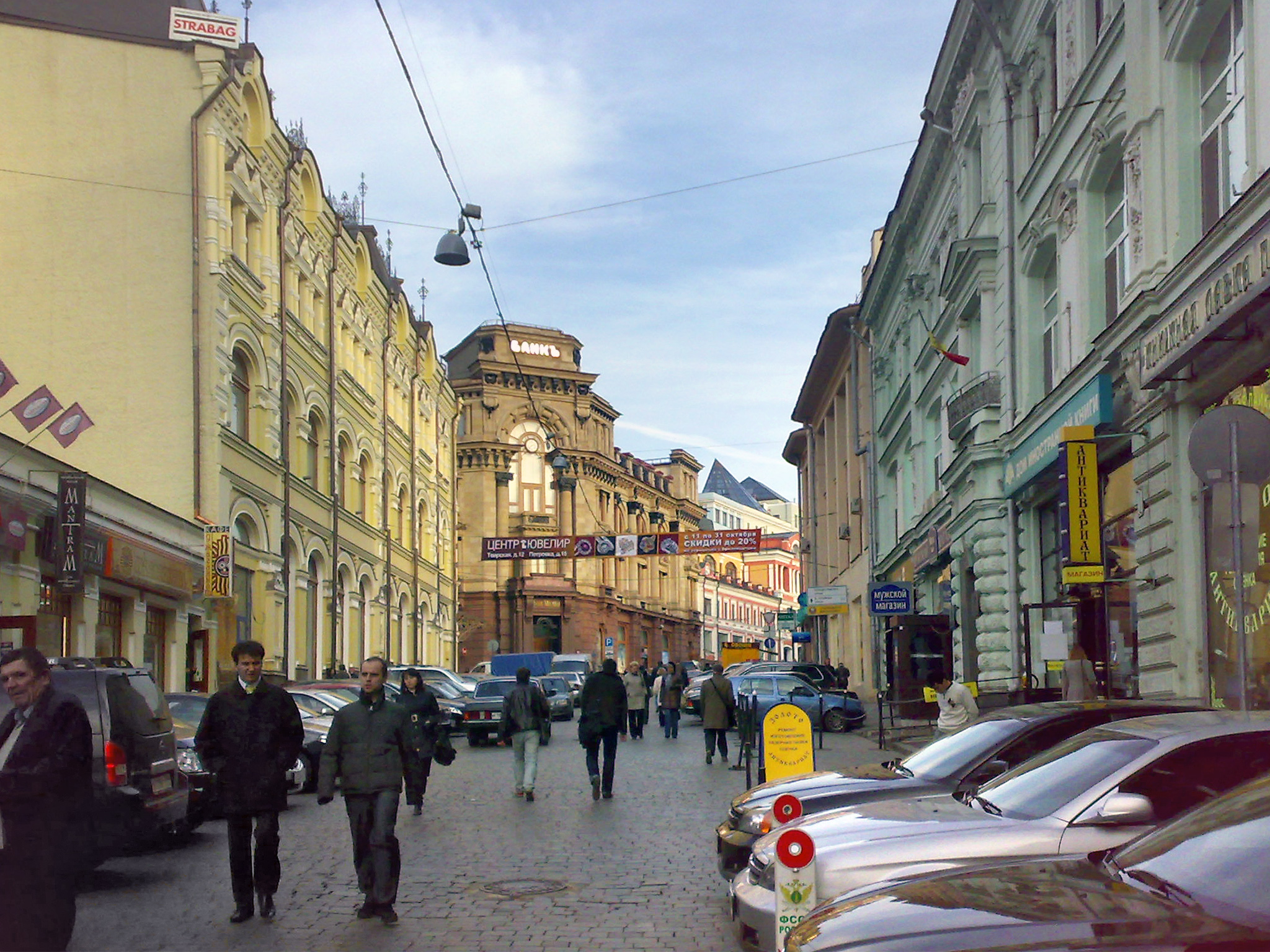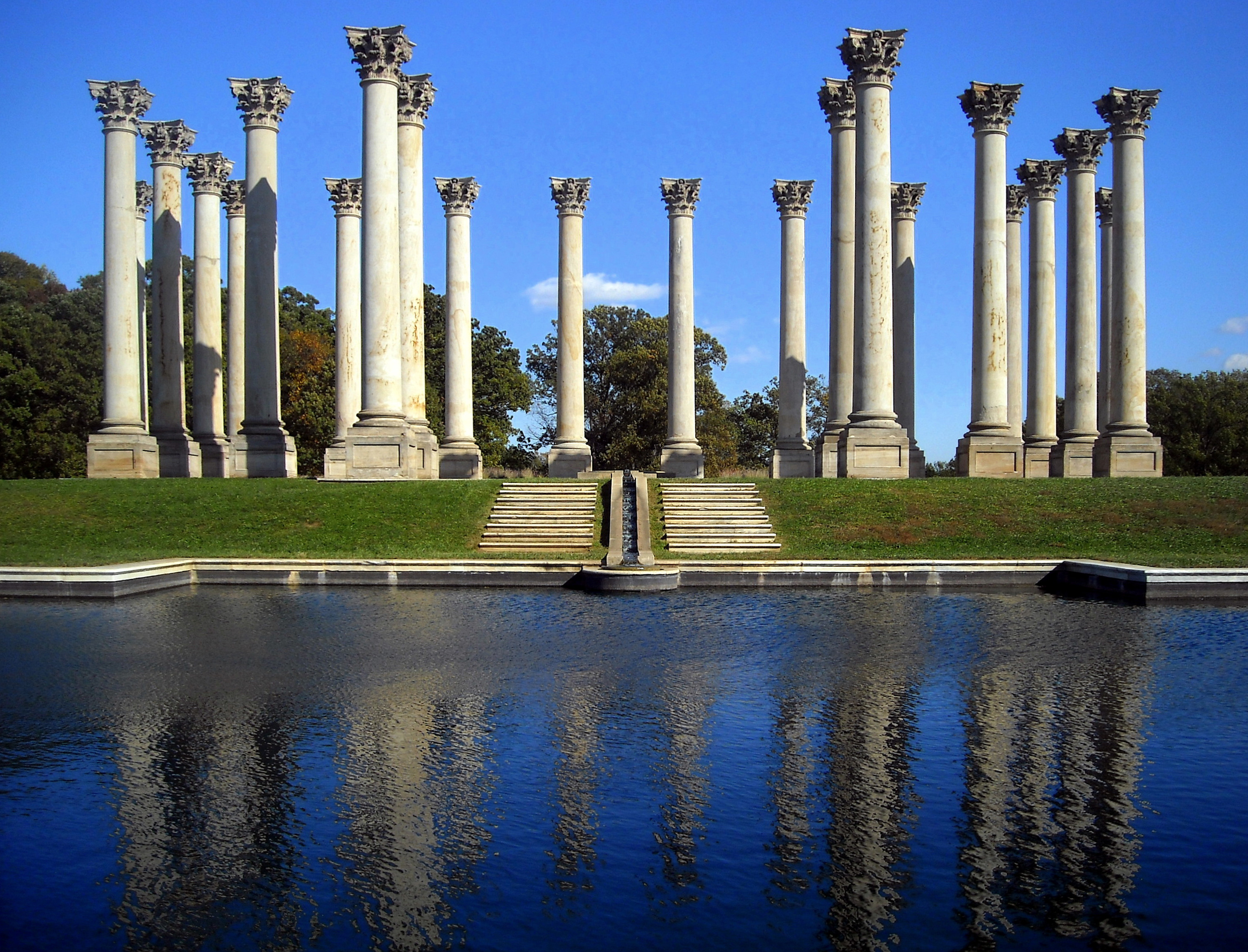|
Kuznetsky Most (Moscow Metro)
Kuznetsky Most (russian: Кузне́цкий мост) is a Moscow Metro station in the Meshchansky District, Central Administrative Okrug, Moscow. It is on the Tagansko-Krasnopresnenskaya Line. Designed by Nina Aleshin and N. Samoylova the station was the first column type to be built since the 1950s. It was opened in 1975 as part of the linking segment between the Zhdanovskaya and Krasnopresnenskaya Line. Decoratively the station is a column tri-vault. The columns are faced with "gazgan" marble archways (reminding one of a viaduct). The floor is covered with polarised black granite Granite () is a coarse-grained ( phaneritic) intrusive igneous rock composed mostly of quartz, alkali feldspar, and plagioclase. It forms from magma with a high content of silica and alkali metal oxides that slowly cools and solidifies und .... The snow-white marble of the walls is decorated with decorative artworks created by M. Alekseyev. The vestibule of the station is located in the c ... [...More Info...] [...Related Items...] OR: [Wikipedia] [Google] [Baidu] |
Moscow Metro Station
There are 250 active stations of the Moscow Metro. Of these, 209 on Moscow Metro proper, and some additional ones that are marketed by Moscow Metro: 6 stations of Moscow Monorail and 31 stations of the Moscow Central Circle. Two stations have been closed. As of 2017 several new stations are under construction or being planned. One station is reserved for future service ( Delovoy Tsentr for the Bolshaya Koltsevaya line). By number of stations the Moscow Metro is ranked 8th, cf. List of metro systems. The deepest station of Moscow Metro, Park Pobedy, is the third-deepest metro station of the world. Active stations Physical characteristics Of the Moscow Metro's 229 stations, 78 are deep underground, 109 are shallow, and 42 (25 of them on the Central Circle) are at or above ground level. Of the latter there are 12 ground-level stations, four elevated stations, and one station ( Vorobyovy Gory) on a bridge. The deep stations comprise 55 triple-vaulted pylon stations, 19 triple ... [...More Info...] [...Related Items...] OR: [Wikipedia] [Google] [Baidu] |
Viaduct
A viaduct is a specific type of bridge that consists of a series of arches, piers or columns supporting a long elevated railway or road. Typically a viaduct connects two points of roughly equal elevation, allowing direct overpass across a wide valley, road, river, or other low-lying terrain features and obstacles. The term ''viaduct'' is derived from the Latin ''via'' meaning "road", and ''ducere'' meaning "to lead". It is a 19th-century derivation from an analogy with ancient Roman aqueducts. Like the Roman aqueducts, many early viaducts comprised a series of arches of roughly equal length. Over land The longest in antiquity may have been the Pont Serme which crossed wide marshes in southern France. At its longest point, it measured 2,679 meters with a width of 22 meters. Viaducts are commonly used in many cities that are railroad hubs, such as Chicago, Birmingham, London and Manchester. These viaducts cross the large railroad yards that are needed for freight trains there, a ... [...More Info...] [...Related Items...] OR: [Wikipedia] [Google] [Baidu] |
Moscow Metro Stations
Moscow ( , US chiefly ; rus, links=no, Москва, r=Moskva, p=mɐskˈva, a=Москва.ogg) is the capital and largest city of Russia. The city stands on the Moskva River in Central Russia, with a population estimated at 13.0 million residents within the city limits, over 17 million residents in the urban area, and over 21.5 million residents in the metropolitan area. The city covers an area of , while the urban area covers , and the metropolitan area covers over . Moscow is among the world's largest cities; being the most populous city entirely in Europe, the largest urban and metropolitan area in Europe, and the largest city by land area on the European continent. First documented in 1147, Moscow grew to become a prosperous and powerful city that served as the capital of the Grand Duchy that bears its name. When the Grand Duchy of Moscow evolved into the Tsardom of Russia, Moscow remained the political and economic center for most of the Tsardom's history. Whe ... [...More Info...] [...Related Items...] OR: [Wikipedia] [Google] [Baidu] |
Moscow Kuznetsky Most Metro Entrance Asv2019-06
Moscow ( , US chiefly ; rus, links=no, Москва, r=Moskva, p=mɐskˈva, a=Москва.ogg) is the capital and largest city of Russia. The city stands on the Moskva River in Central Russia, with a population estimated at 13.0 million residents within the city limits, over 17 million residents in the urban area, and over 21.5 million residents in the metropolitan area. The city covers an area of , while the urban area covers , and the metropolitan area covers over . Moscow is among the world's largest cities; being the most populous city entirely in Europe, the largest urban and metropolitan area in Europe, and the largest city by land area on the European continent. First documented in 1147, Moscow grew to become a prosperous and powerful city that served as the capital of the Grand Duchy that bears its name. When the Grand Duchy of Moscow evolved into the Tsardom of Russia, Moscow remained the political and economic center for most of the Tsardom's history. When t ... [...More Info...] [...Related Items...] OR: [Wikipedia] [Google] [Baidu] |
Kuznetsky Most (Кузнецкий мост) (4178801192)
Kuznetsky Most ( rus, Кузне́цкий Мост, p=kʊˈzʲnʲet͡skʲɪj ˈmost) is a street in central Moscow, that runs from Bolshaya Dmitrovka Street to Lubyanka Street. The name, literally ''Blacksmith's Bridge'', refers to the 18th-century bridge over the (now underground) Neglinnaya River, and a nearby foundry and the settlement of its workers. Since the middle of the 18th century, Kuznetsky Most has been a fashionable shopping street. The street is administered by Tverskoy District (west) and Meshchansky District (east). History Early history Until the end of 15th century, Moscow was growing eastward, into Kitai-gorod. Prince Ivan III of Russia established his arsenal (Пушечный двор, Cannon Court) in the west, beyond the Neglinnaya river. Later, he also set up a settlement of former Pskov residents, abducted from their hometown after the wars of the 1480s. Population grew slowly until the 1737 fire which razed the area. The Bridge Soon after ... [...More Info...] [...Related Items...] OR: [Wikipedia] [Google] [Baidu] |
Lubyanka (Moscow Metro)
Lubyanka (russian: Лубя́нка) is a station on the Sokolnicheskaya Line of the Moscow Metro, located under Lubyanka Square. The facility, originally called ''Dzerzhinskaya'' ( ru , Дзержинская) station, opened in 1935 as part of the first stage of the metro. Name The station was originally named Dzerzhinskaya after Dzerzhinsky Square, but it was changed on 5 November 1990 after the square's original name, Lubyanka, was restored. There is still a bust of Felix Dzerzhinsky in the station vestibule. History Construction work on the station began in December 1933, and the engineers were faced with extremely difficult soil conditions from the outset. The area under Lubyanka square is made of Jurassic clay, beneath which are layers of quicksand and Carboniferous clay. The Metro station was planned to rest on top of the Carboniferous clay, which was thought to be firm enough to support its weight. It was quickly discovered, however, that the clay was much softer than ... [...More Info...] [...Related Items...] OR: [Wikipedia] [Google] [Baidu] |
Granite
Granite () is a coarse-grained ( phaneritic) intrusive igneous rock composed mostly of quartz, alkali feldspar, and plagioclase. It forms from magma with a high content of silica and alkali metal oxides that slowly cools and solidifies underground. It is common in the continental crust of Earth, where it is found in igneous intrusions. These range in size from dikes only a few centimeters across to batholiths exposed over hundreds of square kilometers. Granite is typical of a larger family of ''granitic rocks'', or '' granitoids'', that are composed mostly of coarse-grained quartz and feldspars in varying proportions. These rocks are classified by the relative percentages of quartz, alkali feldspar, and plagioclase (the QAPF classification), with true granite representing granitic rocks rich in quartz and alkali feldspar. Most granitic rocks also contain mica or amphibole minerals, though a few (known as leucogranites) contain almost no dark minerals. Granite is ... [...More Info...] [...Related Items...] OR: [Wikipedia] [Google] [Baidu] |
Marble
Marble is a metamorphic rock composed of recrystallized carbonate minerals, most commonly calcite or dolomite. Marble is typically not foliated (layered), although there are exceptions. In geology, the term ''marble'' refers to metamorphosed limestone, but its use in stonemasonry more broadly encompasses unmetamorphosed limestone. Marble is commonly used for sculpture and as a building material. Etymology The word "marble" derives from the Ancient Greek (), from (), "crystalline rock, shining stone", perhaps from the verb (), "to flash, sparkle, gleam"; R. S. P. Beekes has suggested that a " Pre-Greek origin is probable". This stem is also the ancestor of the English word "marmoreal," meaning "marble-like." While the English term "marble" resembles the French , most other European languages (with words like "marmoreal") more closely resemble the original Ancient Greek. Physical origins Marble is a rock resulting from metamorphism of sedimentary carbonate ro ... [...More Info...] [...Related Items...] OR: [Wikipedia] [Google] [Baidu] |
Meshchansky District
Meshchansky District (russian: Мещанский район) is a district of Central Administrative Okrug of the federal city of Moscow, Russia. Population: The district extends due north from Kitai-gorod to Kamer-Kollezhsky Val. Western boundary with Tverskoy District follows the track of Neglinnaya River ( Neglinnaya Street, Tsvetnoy Boulevard, Samotechnaya Street, Soviet Army Street). Eastern boundary with Krasnoselsky District follows Bolshaya Lubyanka Street and Sretenka Street, then one block east from Mira Avenue. The Lubyanka Building lies in the Meshchansky District. The district contains part of Kuznetsky Most Street, Rozhdestvensky monastery and Rozhdestvensky Boulevard, Olympic Stadium and a row of neoclassical, palace-like buildings north from the Garden Ring. It houses headquarters of Federal Security Service in Lubyanka Square, Central Bank of the Russian Federation, FAPSI and other government agencies. Etymology ''Meshchane'' in the Russian Em ... [...More Info...] [...Related Items...] OR: [Wikipedia] [Google] [Baidu] |
Column
A column or pillar in architecture and structural engineering is a structural element that transmits, through compression, the weight of the structure above to other structural elements below. In other words, a column is a compression member. The term ''column'' applies especially to a large round support (the shaft of the column) with a capital and a base or pedestal, which is made of stone, or appearing to be so. A small wooden or metal support is typically called a '' post''. Supports with a rectangular or other non-round section are usually called '' piers''. For the purpose of wind or earthquake engineering, columns may be designed to resist lateral forces. Other compression members are often termed "columns" because of the similar stress conditions. Columns are frequently used to support beams or arches on which the upper parts of walls or ceilings rest. In architecture, "column" refers to such a structural element that also has certain proportional and decorative f ... [...More Info...] [...Related Items...] OR: [Wikipedia] [Google] [Baidu] |
Nina Alexandrovna Aleshin
Nina Aleksandrovna Aleshina (russian: Нина Александровна Алёшина, IPA: []; July 17, 1924 – November 17, 2012) was a Russian architect and head of the design department ' for the Moscow Metro for a decade. Nineteen stations of the subway system were projects she participated in or led. She was honored with many awards during her career, including the designation in 1985 of Early life Nina Aleksandrovna was born on 17 July 1924 in Moscow, Russian Soviet Federative Socialist Republic, Soviet Union. She was the granddaughter of the Archpriest of the Church of the Resurrection of Christ at Tarusa, Nikolai Uspensky, (russian: Николай Успенский) and his wife Nadezhda Danilovna Yakhontova (russian: Надежда Даниловна Яхонтова), whose children became intellectuals and musicians. She graduated from music school in the same year that the German invasion of Russia occurred. She studied piano, before studying architecture at the ... [...More Info...] [...Related Items...] OR: [Wikipedia] [Google] [Baidu] |




.png)
